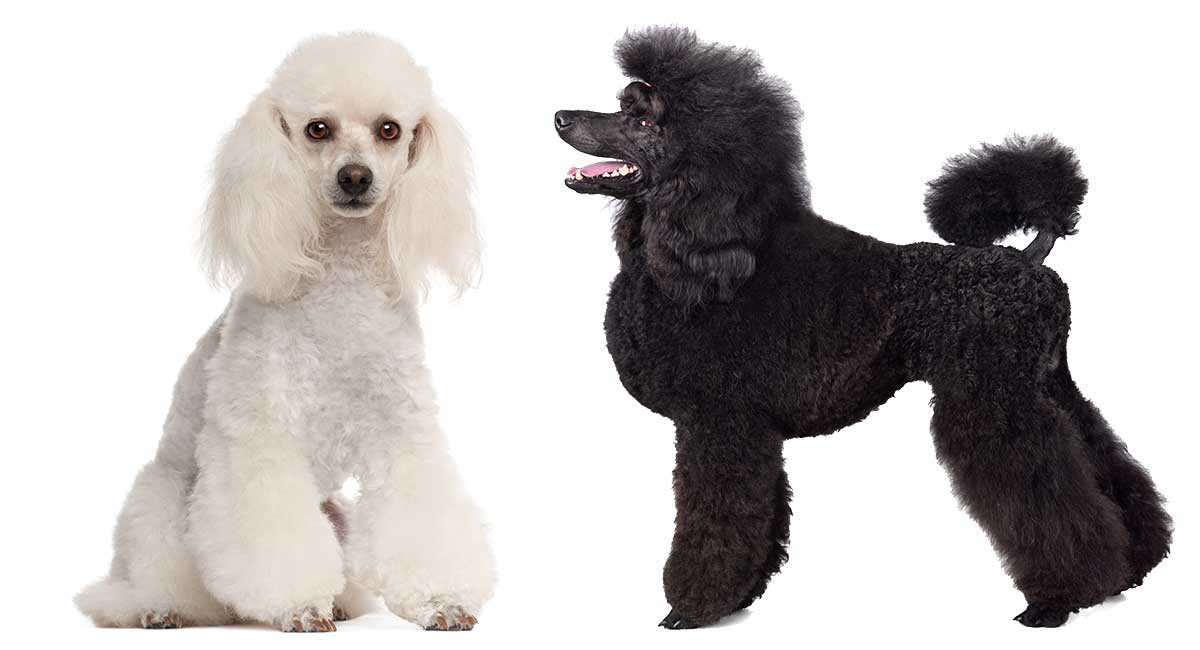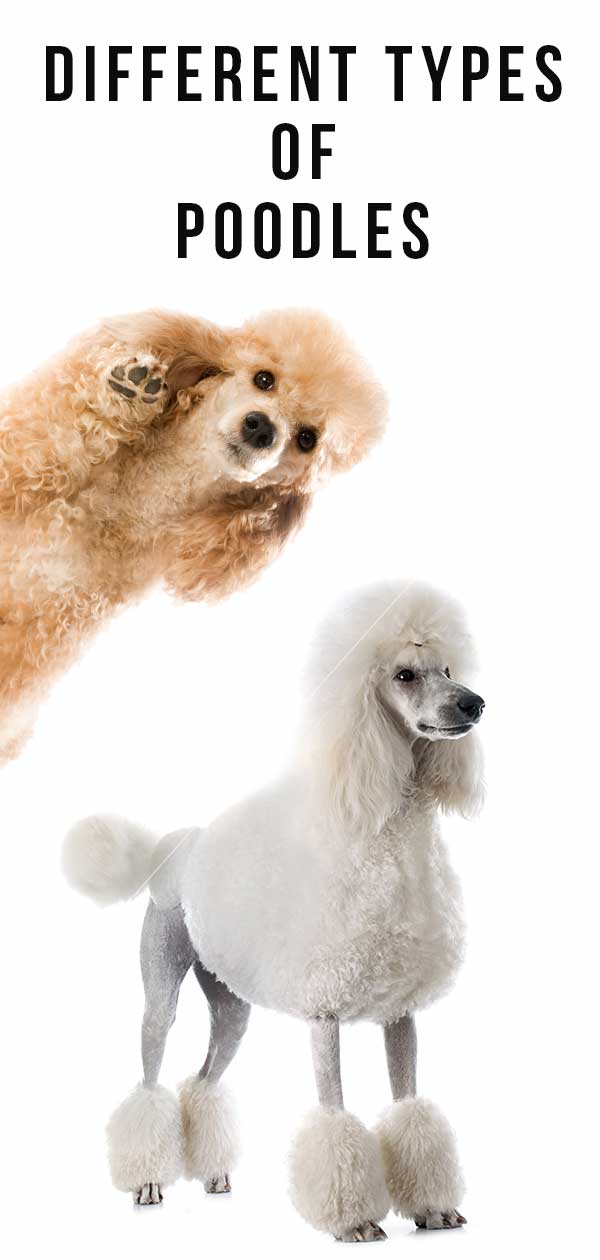
There are three different types of Poodles recognized by the main breed registries in the U.S. and U.K. But, the largest European registry recognizes Poodles in a fourth type!
All different types of Poodles should look like differently sized perfect replicas of each other. But their personality, popularity and health are all different.
Generally Poodles are intelligent, active, and very affectionate and loyal to their families.
Let’s find out more about how the different types of Poodles differ.
Different Types Of Poodles
The three most widely recognized different types of Poodles are:
- Standard Poodles
- Miniature Poodles
- Toy Poodles
These are the three sizes recognized by the American Kennel Club in the US and the Kennel Club in the UK.
Furthermore, the Federation Cynologique Internationale – which is based in Belgium and registers dogs across Europe and internationally – recognizes a ‘medium’ Poodle.
Medium Poodles straddle the bottom of the Standard Poodle size range, and the top of the Miniature Poodle size range.
Contents
In this article, we’ll take a look at:
- Which type of Poodle came first
- How they measure up to each other
- Different types of Poodle personality
- Which Poodles live the longest
- And which is most popular

Which Type of Poodle Came First?
The very first Poodles were Standard Poodles. Standard sized Poodles first started popping up in Germany, in the 15th century.
They were (and still are!) talented and athletic gundogs and retrievers. They had a natural affinity for water, and excelled on duck hunts.
Miniature Poodles came next, by gradually scaling down Standard Poodles over many, many generations.
It’s thought that Miniature Poodles have been owned as both working dogs and companion dogs, but probably most often as companion dogs.
Finally, in the 18th century, came Toy Poodles – the result of even more generations of gradual downsizing.
Toy Poodles have always existed purely as companion dogs and household pets. But even though they’ve never had to work a day in their lives, they are just as smart as their bigger cousins.
Let’s take a closer look at what the different types of Poodle have in common, and what sets them apart!
What Are Poodles Known For?
The most common Poodle stereotype is of a fussy, diva-like dog, with a high-maintenance hair do.
It’s not terribly flattering!
But Poodle owners know them differently. For those in the know, all sizes of Poodle are poised, confident, whip-smart and easy to train.
Poodles are also known for their curly, low shedding coat, which comes in an almost unlimited number of colors.
Their coat can be vast and flamboyant if it’s kept long and well groomed, or short and cute in a puppy or teddy bear clip.
Measuring Up The Different Types Of Poodles
Now let’s see exactly how much the different types of Poodle vary in size.
The Standard Poodle
Breed registries categorize different sizes of dog by their height at their shoulder blades rather than their weight.
This allows for the fact that individuals are all slightly differently built.
Standard Poodles are over 15” tall at the shoulder.
They’re the only type of Poodle which is sexually dimorphic – males are noticeably bigger than females.
Males weigh 60-70lbs and females weigh 40-50lbs.
The Miniature Poodle
Miniature Poodles are between 10” and 15” tall at the shoulder.
They weigh 10-15lbs.
The Toy Poodle
Toy Poodles are shorter than 10” tall at the shoulder.
They can weigh as little as 4lbs, and rarely more than 6lbs.
Medium Poodles!
On the Federation Cynologique Internationale registry, which is based in Belgium and registers dogs across Europe and the rest of the word, there is a fourth category of Poodle.
Medium Poodles are between 35cm and 45cm at the shoulders (approximately 14” and 18”).
The AKC and U.K. Kennel Club regard Standard Poodles as the default Poodle template, of which Miniature and Toy Poodles should be smaller perfect replicas.
But the FCI regards Medium Poodles as the perfect Poodle template, of which Standard, Miniature and Toy Poodles should be bigger, or smaller, replicas.
Different Types Of Poodle Personality
In theory, all sizes of Poodle are meant to be perfectly scaled copies of one another, including their personalities.
But in reality, most Poodle owners are convinced there are differences in temperament between the different Poodle types.
Part of this could be down to their heritage.
Standard Poodles worked for hundreds of years – they needed to be calm, focussed and unflappable in the field.
Toy Poodles have only ever been companion dogs, and purpose-bred companion dogs are more likely to crave attention and interaction. They might also be more prone to separation anxiety.
Smaller Poodles are sometimes thought of as being more excitable too. This could be because all Poodles are lively and intelligent, but Toy Poodles can’t burn off their energy by going on a long hike!
So they might have more energy around the home, until they are given fun games, puzzle toys and training to wear them out!
Are Poodles Aggressive?
Poodles are sometimes thought of as aloof and unfriendly. Some people worry that different types of Poodles might even bark or snap if they try to pet them.
A 2008 study of breed differences in aggression included survey responses regarding 138 Poodles.
Less than 5% of them scored highly for aggression, which puts them somewhat middle of the range compared to all dogs generally.
When Poodles do react by snapping or attempting to bite, it is most likely to be a watchdog-type response to strangers approaching their home.
They are very rarely aggressive towards their families or other dogs.
Careful socialisation as a puppy to all kinds of people out and about and visiting at home is the most sure-fire way to overcome stranger-directed aggression.
It’s just as important to socialize small dogs and teach them great manners, even though we’re naturally more inclined to overlook bad behavior from them.
How Long Do Different Types Of Poodles Live?
A common pattern in all dog breeds is that smaller ones live longer than larger ones. And the same is true of Poodles.
A 2010 survey of dog longevity in the UK found that:
- Standard Poodles lived for an average of 12 years, achieving a maximum of 18 years.
- Miniature Poodles lived 14 years on average, and the oldest survived to 18.5 years.
- And Toy Poodles had an average lifespan of 14.5 years, with one lucky pup reaching 19!
All of these results compared well to the all-dog average of 11.5 years.
But since quality of life is just as important as quantity of life, let’s take a look at the health of each Poodle type next.
Comparing Poodle Health
Dogs’ overall health can vary with their size, and hereditary genetic conditions which inadvertently get fixed into breeding lines.
Across all different types of Poodle there are high rates of hip dysplasia (1 in 9 Poodles are affected) and problems with teeth (1 in 15 Poodles experience this).
Standard Poodles are particularly vulnerable to bloat – approx one quarter of Standard Poodles suffer bloat in their lifetime, and just over 6% of all Standard Poodles die from it.
What About Miniature and Toy Poodles?
Miniature Poodles are the most prone to ear infections – in one study, they accounted for 40% of all dogs treated for yeast infections in the ear.
Miniature and Toy Poodles are more prone to Legg-Perthes disease – a hereditary degenerative condition which affects the top of the thigh bone.
Around one third of Miniature and Toy Poodles carry the genetic mutation which causes the eye disease Progressive Retinal Atrophy (PRA).
Toy Poodles are at greater risk of patella luxation (slipping kneecaps) than Standard or Miniature Poodles. They are also more prone to excess eye watering, which also causes more tear staining.
And finally, all types of Poodle are likely to experience retained testicles than the doggy average, but especially the poor Toy Poodle!
Poodle Health Testing
One of the best ways to secure your puppy a healthy life is to choose them from health tested parents.
Standard Poodle parents should be screened for:
- hip dysplasia
- good eyesight
- and either thyroid disease, skin diseases or cardiac disease
What About Smaller Types?
Breeding Miniature Poodles should be tested for:
- hip dysplasia
- patella luxation
- the gene which causes PRA
- and good eyesight generally
And Toy Poodle studs and dams should have clear health certificates for:
Which Types Of Poodles Are Most Popular?
This is a tricky question to answer.
The AKC doesn’t distinguish between the types of Poodle on its registry, so all three share the position of 7th most registered breed in 2018.
Out of 195 breeds overall, that’s an impressive place to hold!
Use of Surveys
If we take another look at the 2010 longevity survey, we can see that the researchers sent questionnaires to breed clubs across the U.K.
The responses from the Poodle clubs included details about 237 Standard Poodles, 81 Miniature Poodles, and 48 Toy Poodles.
Suggesting that in the U.K. at least, the Standard Poodle still has the most fans.
Of course, there will be regional variations all over the world.
For example small types of Poodle are more likely to be popular in towns and cities, where living space and outdoor space for exercise is at a premium.
Which Is Your Favorite Type Of Poodle?
Have you already pledged your loyalty to one type of Poodle above all others?
Tell us which, and the reasons why, down in the comments box!
References & Resources
- Orthopedic Foundation For Animals
- American Kennel Club
- Cavanagh & Bell, Veterinary Medical Guide To Dog and Cat Breeds, CRC Press, 2012.
- Adams et al, Methods and mortality results of a health survey of purebred dogs in the UK, Journal of Small Animal Practice, 2010.
- Duffy, Breed Differences In Canine Aggression, Applied Animal Behavior Science, 2008.
- McGreevy, Dog Behavior Co-Varies with Height, Bodyweight and Skull Shape, Plos One, 2013.

Ella says
Toy Poodle: Cause that’s my dog!!